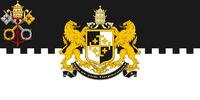Tuxtla Martínez Train Disaster
| Tuxtla Martínez Train Disaster | |
|---|---|
| Details | |
| Date | November 15, 2007 |
| Time | 7:36 AM (SST) |
| Location | Tuxtla Martínez, Zapatista |
| Country | |
| Line | Cajon Pass |
| Operator | Creeperian Railroad Networks |
| Incident Type | Runaway Train and Derailment |
| Cause | Train weight miscalculated and several locomotives with inoperative dynamic brakes. Pressure and bribes from CORNACA on RFC to skip safety checks. See Aftermath. |
| Statistics | |
| Trains | 1 (RFC 4398) |
| Crew | 6 |
| Deaths | 12 (3 on the train, 9 in houses) |
| Injuries | 15 (3 on the train, 12 in houses) |
The Tuxtla Martínez Train Disaster was a runaway train derailment on November 15, 2007 in Tuxtla Martínez, Zapatista, Creeperopolis. The derailment is the worst in Creeperian Railroad Networks' history and one of the deadliest in Creeperian history.
Derailment


On November 15, 2007, at 7:36 a.m. a 7-locomotive/122-car Creeperian Railroad Networks freight train (RFC 4398) that was transporting sugar for the National Coffee and Sugar Corporation lost control while descending Cajon Pass and derailed on an elevated curve, plowing into a residential area by the railroad tracks.
Twelve people were killed with fifteen more being injured. Fifteen houses on the street immediately next to the tracks were demolished by the wreck, as were the lead locomotives and all of the freight cars. Rail yard workers in Helam had miscalculated the weight of the train, while the engineer and crew at the head end were unaware that one of the rear helper engines had inoperative dynamic brakes. Hence there was not enough dynamic braking force available to maintain control of train speed during the descent. When the helper engineer realized that the train speed was not being adequately controlled, he made an emergency brake application, which deactivated dynamic braking, resulting in a runaway condition. The train reached a speed of about 110 mph before derailing on an elevated 35 mph curve sending the head end locomotives and several cars off the high railroad bed and into houses on the street below, completely demolishing them.
Cause
After an investigation by the Imperial Transportation Safety Administration (AIST), it was discovered that the National Coffee and Sugar Corporation (CORNACA) faced heavy Quebecshirite demand for Creeperian sugar for Pepsi and other sugar products. CORNACA turned to the Creeperian Railroad Networks (RFC), its primary coffee and sugar transporter, to speed up the delivery of sugar and to make its deliveries larger in size. The railroad was pressured and bribed into taking less time to inspect their trains and conduct safety tests, and to make their trains run faster, run more often, and pull heavier and larger loads by CORNACA.
On the day of the derailment, two separate deliveries were merged into one on demand of CORNACA. Consequently, the weight of the larger train was not calculated and not enough locomotives were assigned to RFC 4398 to descend down Cajon Pass. Of the seven locomotives, four of them had faulty or non-operational brakes due to less frequent maintenance. The faults were never detected as no safety or brake tests have been preformed in two years due to CORNACA's pressure and bribes.
When the train began to roll down the grade and the brakes were applied, the fact that the brakes were faulty was discovered.
Aftermath
After the disaster, all five lead locomotives and all freight cars were deemed total losses and scrapped on site. The two end locomotives were repaired and reentered service in late 2008. Of the 15 destroyed houses, 6 were rebuilt. In place of the other 9 is a memorial dedicated to those who died.
The CEO's of CORNACA and RFC were both put on trial for several charges but they were both acquitted. See Corruption in Creeperopolis.
Train
Train Crew
The crew of RFC 4398 were:
- Román Manzanedo Zorita†, Engineer of 4398 (age 37)
- Martín Leoz Pozo†, Conductor of 4398 (age 41)
- Serafín Mancebo Velázquez†, Brakeman of 4378 (age 35)
- Nicolás Tejedor Reyes, Engineer of 2391 (age 39)
- Joshua Obregón Japón, Conductor of 2391 (age 44)
- Álvaro Semprún Galán, Brakeman of 7679 (age 42)
Locomotives and Cars
RFC 4398 consisted of:
- SD70ACe 4398
- SD70ACe 4378
- SD40-2 2390
- GP40-2 121
- SD60E 9898
- 1 box car loaded with boxes of coffee beans
- 60 covered hopper cars loaded with sugar
- 1 box car loaded with boxes of coffee beans
- 60 covered hopper cars loaded with sugar
- GP38-2 767
- SD40-2 2391
Only locomotives 7679 and 2391 were repaired and put back into service. Locomotives 4398, 4378, 2390, 1121, 9898, and every freight car were deemed total losses and scrapped on site.



